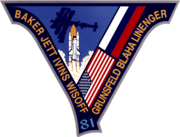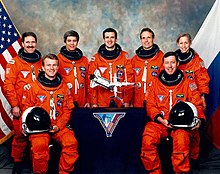STS-81
Shuttle-Mir | |
| Operator | NASA |
|---|---|
| COSPAR ID | 1997-001A |
| SATCAT no. | 24711 |
| Mission duration | 10 days, 4 hours, 56 minutes, 30 seconds |
| Distance travelled | 6,100,000 kilometres (3,800,000 mi) |
| Orbits completed | 160 |
| Spacecraft properties | |
| Spacecraft | Space Shuttle Atlantis |
| Payload mass | 2,250 kilograms (4,960 lb) |
| Crew | |
| Crew size | 6 |
| Members |
|
| Launching | |
| Landing | |
| Start of mission | |
| Launch date | January 12, 1997, 09:27:23 UTC |
| Launch site | Kennedy LC-39B |
| End of mission | |
| Landing date | January 22, 1997, 14:23:51 UTC |
| Landing site | Kennedy SLF Runway 33 |
| Orbital parameters | |
| Reference system | Geocentric |
| Regime | Low Earth |
| Perigee altitude | 380 kilometres (240 mi) |
| Apogee altitude | 392 kilometres (244 mi) |
| Inclination | 51.6 degrees |
| Period | 92.2 min |
| Docking with Mir | |
| Docking port | SO starboard |
| Docking date | January 15, 1997, 03:54:49 UTC |
| Undocking date | January 20, 1997, 02:15:44 UTC |
| Time docked | 4 days, 22 hours, 20 minutes 55 seconds |

 Left to right - Front: Jett, Baker; Back: Grunsfeld, Blaha, Wisoff, Linenger, Ivins | |
STS-81 was a January 1997 Space Shuttle Atlantis mission to the Mir space station.
Crew
| Position | Launching Astronaut | Landing Astronaut |
|---|---|---|
| Commander | Michael A. Baker Fourth and last spaceflight | |
| Pilot | Brent W. Jett, Jr. Second spaceflight | |
| Mission Specialist 1 | Peter J.K. Wisoff Third spaceflight | |
| Mission Specialist 2 | John M. Grunsfeld Second spaceflight | |
| Mission Specialist 3 | Marsha Ivins Fourth spaceflight | |
| Mission Specialist 4 | Jerry M. Linenger EO-22 Second and last spaceflight |
John E. Blaha EO-22 Fifth and last spaceflight |
Mission highlights

STS-81 was the fifth of nine planned missions to Mir and the second one involving an exchange of U.S. astronauts. Astronaut John Blaha, who had been on Mir since September 19, 1996, was replaced by astronaut Jerry Linenger. Linenger spent more than four months on Mir. He returned to Earth on Space Shuttle Mission STS-84.
Atlantis carried the
The STS-81 mission included several experiments in the fields of advanced technology,
On January 18, while Atlantis was docked to Mir, Grunsfeld placed a telephone call to the NPR show

STS-81 involved the transfer of 2,710 kilograms (5,970 lb) of logistics to and from the Mir, the largest transfer of items to date. During the docked phase, 635 kilograms (1,400 lb) of water, 516.1 kilograms (1,138 lb) of U.S. science equipment, 1,000.7 kilograms (2,206 lb) of Russian logistics along with 121.7 kilograms (268 lb) of miscellaneous material was transferred to Mir. Returned to Earth aboard Atlantis was 570.0 kilograms (1,256.6 lb) of U.S. science material, 404.5 kilograms (892 lb) of Russian logistics and 97.3 kilograms (215 lb) of miscellaneous material.
First Shuttle flight of 1997 highlighted by return of U.S. astronaut John Blaha to Earth after 118-day stay aboard Russian Space Station Mir and the largest transfer to date of logistics between the two spacecraft. Atlantis also returned carrying the first plants to complete a life cycle in space — a crop of wheat grown from seed to seed. This fifth of nine planned dockings continued Phase 1B of the NASA/
Blaha joined Mir 22 crew of Commander

Docking occurred at 22:55 EST, January 14, followed by hatch opening at 00:57 January 15. Linenger officially traded places at 04:45 with Blaha who spent 118 days on the station and 128 days total on-orbit. During five days of mated operations, crews transferred nearly 6,000 pounds (2,722 kilograms) of logistics to Mir, including around 725 kilograms (1,598 lb) of water; around 516 kilograms (1,138 lb) of U.S. science equipment; and 1,001 kilograms (2,207 lb) of Russian logistical equipment. About 1,100 kilograms (2,400 lb) of materials returned with Atlantis from Mir.
Crew also tested on Shuttle the Treadmill Vibration Isolation and Stabilization System (TVIS), designed for use in the Russian Service Module of the International Space Station. Another activity related to International Space Station involved firing the orbiter's small vernier jet thrusters during mated operations to gather engineering data.
Undocking occurred at 09:15 EST, January 19, followed by fly around of Mir.
No significant in-flight anomalies were experienced with Atlantis.
Wake-up calls
NASA began a tradition of playing music to astronauts during the
Each track is specially chosen, often by their families, and usually has a special meaning to an individual member of the crew, or is applicable to their daily activities.[2]| Flight Day | Song | Artist/Composer |
|---|---|---|
| Day 2 | "Free Ride" | The Edgar Winter Group |
| Day 3 | "It Keeps You Runnin'" | The Doobie Brothers |
| Day 4 | "Hitchin' a Ride" | Vanity Fare |
| Day 5 | "Celebration" | Kool and the Gang
|
| Day 6 | "I Got You (I Feel Good)" | James Brown |
| Day 7 | "Mack the Knife" | Bobby Darin |
| Day 8 | "Ticket to Ride" | The Beatles |
| Day 9 | "My Favorite Marsha" | The Alison Brown Quartet |
| Day 10 | " The Banana Boat Song "
|
Harry Belafonte |
See also
References
![]() This article incorporates public domain material from websites or documents of the
This article incorporates public domain material from websites or documents of the
- ^ "io9 - The time an astronaut called into Car Talk from the Space Shuttle". July 9, 2012. Archived from the original on June 15, 2016. Retrieved May 28, 2016.
- ^ a b Fries, Colin (June 25, 2007). "Chronology of Wakeup Calls" (PDF). NASA. Archived (PDF) from the original on June 20, 2010. Retrieved August 13, 2007.
External links
- NASA mission summary Archived May 20, 2007, at the Wayback Machine
- STS-81 Video Highlights Archived October 13, 2007, at the Wayback Machine



